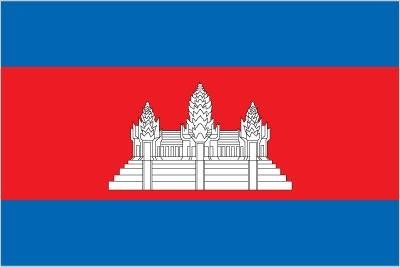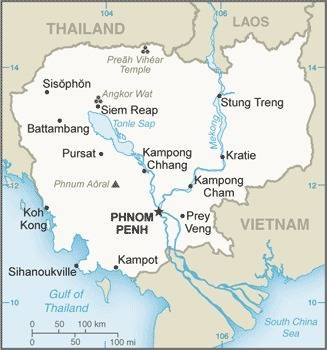133 Cambodia

Three horizontal bands of blue (top), red (double width), and blue with a white, three-towered temple, representing Angkor Wat, outlined in black in the center of the red band. Red and blue are traditional Cambodian colors.
Flag courtesy of the CIA World Factbook

Map courtesy of the CIA World Factbook

On the grounds of the Royal Palace in Phnom Penh. The palace area contains at least three stupas with royal remains.
Photo courtesy of the CIA World Factbook
Government
According to Britannica, in 1981 the Vietnam-backed communist government in Phnom Penh established a government based on a new constitution. That government was opposed by three factions that in 1982 formed a coalition government-in-exile. Though that coalition was unable to rule in Cambodia, it gained international recognition, held on to Cambodia’s seat at the United Nations (UN), and was able to negotiate with the Phnom Penh government.
In 1991 the government and opposition groups signed peace accords that provided for the creation of a new national government. The UN established a transitional authority to oversee the implementation of the accords, including elections in 1993 that formed a coalition government led by Prince Norodom Sihanouk. A new constitution was adopted in September that restored the pre-1970 Kingdom of Cambodia, though now as a constitutional monarchy and a multiparty liberal democracy. Sihanouk immediately ascended the throne under the new constitution.
Under the constitution, the king, who is the head of state, is chosen from among royal descendants by the Royal Throne Council. In 2004 King Sihanouk decided to abdicate, and Prince Norodom Sihamoni was selected to succeed him.
Cambodia’s legislature has been bicameral since 1999, with the directly elected National Assembly as its lower chamber and the indirectly elected (by commune councillors) Senate as its upper chamber. Members of the parliament serve five-year terms. Executive power resides with the cabinet, headed by a prime minister—who is chosen by the king, based on the recommendation of the chairman of the National Assembly, from the representatives of the party with the largest number of seats in the assembly. The remaining government ministers are selected from all parties represented in the assembly.
Local government, at the highest level, consists of provinces and municipalities. Each province (khet) is headed by a governor and is divided into districts (srok), communes (khum), and villages (phum). Each municipality (krong) is led by a mayor and is subdivided into sectors (khan) and wards (sangkat). At each level of local government, a People’s Assembly, composed of representatives elected by popular vote, chooses a People’s Committee that has formal responsibility within the locality for public administration and security. Within each province, effective control over the armed forces and security units, the civil bureaucracy, and tax collection is in the hands of the governor and provincial officials.
The country has a constitutionally independent judiciary composed of lower courts, an appeals court, and a Supreme Court. However, the judiciary has been closely allied with Cambodia’s ruling party and often has been suspected of corruption. A nine-member Constitutional Council determines the constitutionality of legislation. It also resolves electoral disputes. The Supreme Council of Magistrates appoints and disciplines judges. There is also a separate military justice system.
State Secretariat of Civil Aviation
Formal regulation of civil aviation in Cambodia goes back to the point at which Cambodia became a signatory nation of the ICAO in 1953, and adopted French regulations on a temporary basis in 1954 until national regulation could be developed and applied. Responsibility for regulation of civil aviation became a function of the Ministry of Public Works and Communications. Regulatory responsibility for civil aviation has been maintained by the Government of Cambodia ever since, with a brief interruption in the mid-to-late 1970’s during the period of internal civil disruption. In the years that have passed since that time, responsibility for regulation of civil aviation has been based in different ministries of the Government of Cambodia, finally evolving into the present regulatory agency, the State Secretariat of Civil Aviation, which reports directly to the Council of Ministers.
Airspace
SkyVector – Google Maps – ADS-B Exchange
ICAO countries publish an Aeronautical Information Publication (AIP). This document is divided into three parts: General (GEN), En Route (ENR) and Aerodromes (AD). ENR 1.4 details the types of airspace classes they chose to adopt from classes A through G.
CATS
Cambodia Air Traffic Services Company Limited (CATS) – Cambodia’s Air Navigation Service Provider (ANSP), was established in April 2001 by SAMART Corporation Public Company Limited which gained exclusive license from the Royal Government of the Kingdom of Cambodia to develop and operate the air traffic control and navigation systems in Cambodia under the Build, Corporate and Transfer (BCT) terms and conditions.
CATS has eventually been designated as the service provider of Aeronautical Information Services (AIS) / Aeronautical Information Management (AIM), Aeronautical Charts and Flight Procedure Design.
Drone Regulations
Cambodian CARs – Currently, there is no legal framework for the use of drones.
Flying drones in Cambodia – 2023
Advanced Air Mobility (AAM) Regulations & Policies
None found by the author.
However, should you, the reader, happen to stumble across something to the contrary, please email the author at FISHE5CA@erau.edu and you may be mentioned in the ACKNOWLEDGEMENTS section of this book by way of thanks for contributing to this free eBook!
Advanced Air Mobility (AAM) News
2025
Video courtesy of Advanced Air Mobility Institute from the January 2025 Global AAM Forum. Complete session for Day 3 of this Forum is available on the Advanced Air Mobility Institute YouTube Channel
Short Essay Questions
Scenario-Based Question
You have been hired by a Drone Startup Company. Your boss has immediately assigned this job to you.
They need you to prepare a one-page memo detailing the legalities of using a drone to film in Phnom Penh, pictured above.
They need you to mention any national laws and local ordinances.
They specifically want to know what airspace (insert pictures) you will be operating in and whether or not you need an airspace authorization.
Does it matter whether or not you are a citizen of the country?
Lastly, there is a bonus for you if, as you scroll through this chapter, you find any typos or broken links!
Short Essay Questions
- What are the drone categories?
- How is registration addressed?
- How is remote ID addressed?
- What are the model aircraft rules?
- What are the commercial drone rules?
- Are there waivers or exemptions to the rules? If so, for what?
- Would you share a link to an interactive airspace map?
- How is BVLOS addressed?
- How can you fly drones at night?
- How can you fly drones over people?
- Where do you find drone NOTAMs?
- What are the rules for drone maintenance?
- What are the rules for an SMS program?
- What are some unique rules not mentioned above?
- What are the C-UAS rules?
- What are the AAM rules?

